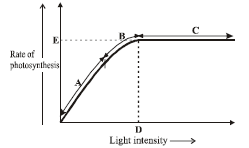Please see Chapter 13 Photosynthesis in Higher Plants Exam Questions Class 11 Biology below. These important questions with solutions have been prepared based on the latest examination guidelines and syllabus issued by CBSE, NCERT, and KVS. We have provided Class 11 Biology Exam Questions and answers for all chapters in your NCERT Book for Class 11 Biology. These solved problems for Biomolecules in Class 11 Biology will help you to score more marks in upcoming examinations.
Exam Questions Chapter 13 Photosynthesis in Higher Plants Class 11 Biology
Objective Questions
Question. Photosynthesis is important because
(a) it is the primary source of food on earth.
(b) it is responsible for release of O2 into the atmosphere by green plants.
(c) it is responsible for release of water vapour into the atmosphere.
(d) both (a) and (b)
Answer
D
Question. One of the earliest experiments on photosynthesis was done in 1770 by Joseph Priestley. He demonstrated that
(a) sun is the ultimate source of energy.
(b) water is essential for life.
(c) plants & animals “restore” the air for each other.
(d) chlorophyll captures light energy.
Answer
C
Question. The experiment material used by Van Neil, to prove that O2 comes out from water was studied on
(a) Chlorella pyrenoidosa
(b) Cladophora
(c) purple & green sulphur bacteria
(d) blue green algae
Answer
C
Question. How can we separate leaf pigments of any green plant?
(a) Column chromatography
(b) Paper chromatography
(c) Electrophoresis
(d) Radio-isotopes
Answer
B
Question. The light harvesting complex (LHC) is made up of
(a) one molecule of Chl a.
(b) very few molecules of Chl a.
(c) hundreds of pigment molecules bound to proteins.
(d) Chl a + Chl c + protein + DNA.
Answer
C
Question. In PS-I, the reaction centre Chl a has absorption maxima at _____________, while in PS-II the reaction centre Chl a has absorption maxima at ___________.
(a) P680, P700
(b) P700, P680
(c) P800, P600
(d) P700, P900
Answer
B
Question. Electrons are picked up by an electron acceptor which passes them to an electron transport system consisting of
(a) phytochromes
(b) cytochromes
(c) Z-scheme
(d) redox potential scale
Answer
B
Question. Correct equation that represents the photolysis of water is
(a) 2H2O → 4H+ + O2 + 4e–
(b) H2O →4H+ + O2 + 4e–
(c) 4H2O → 4H+ + O2 + 4e–
(d) 2H2O → 4H+ + 2O2 + 2e–
Answer
A
Question. ATP synthesis, in photosynthesis involves the
(a) establishment of a protein gradient.
(b) oxidation of water.
(c) reduction of NADP+.
(d) flow of electrons.
Answer
A
Question. The light-driven synthesis of ATP & NADPH, provides energy and reducing power for the
(a) conversion of inorganic carbon into organic carbon.
(b) fixation of CO2 into trioses.
(c) for the production of sugars.
(d) all of the above.
Answer
D
Statement Type Questions
Question. Which of the following statement(s) is/are correct about RuBisCO?
(a) It catalyzes the fixation of CO2.
(b) It has oxygenation & carboxylation both activity.
(c) It is the most abundant protein on earth.
(d) All of the above
Answer
D
Question. Which one of the following statement is incorrect in relation to photorespiration?
(a) It is a characteristic of C3 plants.
(b) The RuBP binds with O2 to form one molecule of phosphoglycerate and phosphoglycolate.
(c) There is synthesis of ATP or NADPH.
(d) It occurs in daytime only.
Answer
C
Question. Which of the following statements (i-iv) regarding “Splitting of water” is/are correct.
(i) It is photolysis of water which provides H+ ions for synthesis of NADPH.
(ii) It provides electrons for photophosphorylation & activation of NADP+.
(iii) O2 is evolved during this process.
(iv) It replenishes O2 consumed by living beings and combustion.
(a) One
(b) Two
(c) Three
(d) All
Answer
D
Question. Why C4 plants are special ? Because,
(i) they have a special type of leaf anatomy.
(ii) they tolerate higher temperatures.
(iii) they show a response to high light intensities.
(iv) they lack a process called photorespiration.
(v) they have greater productivity of biomass.
(a) (i) and (ii)
(b) (i), (iii) and (iv)
(c) (i), (ii), (iii) and (iv)
(d) All of these
Answer
D
Assertion/Reason Type Questions
In the following questions, a statement of Assertion is followed by a statement of Reason.
(a) If both Assertion and Reason are true and the Reason is the correct explanation of the Assertion.
(b) If both Assertion and Reason are true but the Reason is not the correct explanation of the Assertion.
(c) If Assertion is true but Reason is false.
(d) If both Assertion and Reason are false.
Question. Assertion: C4 pathway of CO2 fixation is found in some tropical plants.
Reason: In this pathway, CO2 is fixed by 3C compound.
Answer
B
Question. Assertion: Bacterial photosynthesis occurs by utilizing wavelength longer than 700 nm.
Reason: Here reaction centre is B-890.
Answer
B
Question. Assertion : Cyclic pathway of photosynthesis first appeared in some eubacterial species.
Reason : Oxygen started accumulating in the atmosphere after the non-cyclic pathway of photosynthesis evolved.
Answer
B
Matching Type Questions
Question. The given figure shows the graph of light intensity (on xaxis) on the rate of photosynthesis (on y-axis). Few points are marked as A, B, C, D and E.

Match the marked alphabets given in column I with these correct interpretation given in column II.
| Column – I | Column – II |
| A. Limiting factor in region A | I. Some factor other than light intensity is becoming the limiting factor |
| B. B represents | II. Light is no longer limiting factor |
| C. C represents | III. Light intensity |
| D. D represents | IV. Maximum rate of photosynthesis |
| E. E represents | V. Saturation point for light intensity |
The correct option is
(a) A – I; B – II; C – III; D – IV; E – V
(b) A – III; B – I; C – II; D – V; E – IV
(c) A – IV; B – II; C – V; D – III; E – I
(d) A – V; B – IV; C – III; D – II; E – I
Answer
B
Question. Which of the following pair is mismatched?
(a) Photosystem I – Uses the P700 molecule in its photocenter.
(b) Antenna complex – Contains hundreds of pigment molecule.
(c) PGA – 3- carbon compound.
(d) Dark reaction – Takes place in the grana of the chloroplast.
Answer
D
Question. Match column-I with column-II and choose the correct combination from the options given below.
| Column -I | Column -II |
| A. Oxygen evolving complex ferric oxalate | I. Pigments |
| B. Proton gradient concentration | II. High oxygen |
| C. Absorb light at specific wavelengths. | III. ATP synthesis |
| D. Photorespiration | IV. Photolysis of water |
(a) A – IV; B – III; C – I; D – II
(b) A – IV; B – I; C – III; D – II
(c) A – II; B – I; C – IV; D – III
(d) A – II; B – IV; C – III; D – I
Answer
A
Question. Which of the following is incorrectly matched?
(a) Sorghum — Kranz anatomy
(b) PS – II — P700
(c) Photorespiration — C3 plants
(d) PEP carboxylase — Mesophyll cells
Answer
A
Critical Thinking Type Questions
Question. The reactions of Calvin cycle not directly dependent on light, but they usually do not occur at night. Why?
(a) Night is often too cold for these reactions to occur.
(b) CO2 concentration in night is too high for these reactions to occur.
(c) Plants usually open their stomata at night.
(d) Calvin cycle is dependent on the products of light reaction.
Answer
D
Question. Chloroplasts are disrupted and the stroma separated from the lamellae. The isolated stroma will fix CO2 if it is supplied with
(a) O2
(b) RuBisCO
(c) light
(d) ATP + NADPH
Answer
D
Question. Which of following ratio is correct for the production of one molecule of glucose through 6 rounds of Calvin cycle?
| CO2 | ATP | NADPH2 |
| (a) 1 | 2 | 2 |
| (b) 6 | 18 | 12 |
| (c) 6 | 12 | 18 |
| (d) 5 | 6 | 9 |
Answer
B
Question. In an experiment, the CO2 available to a C4 plant was labelled with a radioactive isotope and the amount of radioactivity in the chloroplast was measured. As photosynthesis preceeded, in which of the following molecules did the radioactivity first appear?
(a) Oxaloacetic acid
(b) PEP
(c) Malic acid
(d) RuBP
Answer
A
Question. According to Blackman’s law of limiting factor, at any given time, photosynthesis can be limited by
(a) light only
(b) CO2 concentration only
(c) both light and CO2 concentration
(d) either by light or by CO2
Answer
D
Question. Why, at higher light intensities, gradually photosynthesis rate does not show further increase?
(a) Higher light intensity activate more chlorophylls.
(b) Higher light intensity causes more transpiration.
(c) No need of more sugar formation.
(d) Other factors become limiting.
Answer
C
Question. In C4 (sugarcane plant) plant,14CO2 is fixed in malic acid in which the enzyme that fixes CO2 is
(a) fructose phosphatase
(b) ribulose biphosphate carboxylase
(c) phosphoenol pyruvic acid carboxylase
(d) ribulose phosphate kinase
Answer
C
Question. A student sets up an experiment on photosynthesis as follows:
He takes soda water in a glass tumbler and add chlorophyll extracts into the contents and keeps the tumbler exposed to sunlight hoping that he has provided necessary ingredients for photosynthesis to proceed (viz., CO2, H2O, chlorophyll and light). What do you think what will happen after, say, a few hours of exposure of light?
(a) Photosynthesis will take place and glucose will be produced.
(b) Photosynthesis will take place and starch will be produced which will turn the mixture turbid.
(c) Photosynthesis will not take place because CO2 dissolved in soda water escapes into the atmosphere.
(d) Photosynthesis will not take place because intact chloroplasts are needed for the process.
Answer
D
Question. ADP is phosphorylated and NADP is reduced, this happens during.
(a) dark phase of photosynthesis
(b) light phase of photosynthesis
(c) Photorespiration
(d) Calvin cycle
Answer
B
Question. During the light stage of photosynthesis, the photoactivated pigment removes an electron from the hydroxylation derived from the water molecule.
The fate of the free hydroxyl radical is that it
(a) is broken down into oxygen and a free radical of hydrogen.
(b) is used to raise the activation level of chlorophyll by donating a positive charge.
(c) is used to produce adenosine triphosphate from adenosine diphosphate.
(d) reduces carbon dioxide to sugar.
Answer
A

